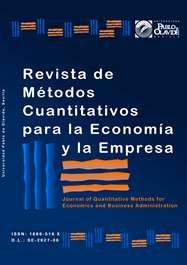Seasonality in fuel consumption: a case study of a gas station
DOI:
https://doi.org/10.46661/revmetodoscuanteconempresa.4350Keywords:
diesel, fuel, gasoline, seasonalityAbstract
Oil and its derivatives are very important goods in the world, not only because of their huge use but also because the consequences of that use. The literature has plenty of works with economic analysis of the use of oil. Having available a huge amount of data, we propose an innovative approach: based on daily information of sales in a gas station since 2001 to 2018, we make a seasonality analysis of those sales. In separate analysis, using information of the both existing shifts, of the week day and of the month, we conclude that seasonality in sales is significant. This is an important information for firm managers, which could use this information to better define their strategies.
Downloads
References
Backus, D., & Crucini, M. (2000). Oil Prices and the terms of trade. Journal of International Economics, 50(1), 185-213. https://doi.org/10.1016/S0022-1996(98)00064-6.
Bacon, R. (1986). UK gasoline prices: How fast are changes in crude prices transmited to the pump? Oxford Institute for Energy Studies EE2.
Bacon, R. (1991). Rockets and Feathers: The asymmetric speed of adjustment of UK retail gasoline prices to cost changes. Energy Economics, 13, 211-218. https://doi.org/10.1016/0140-9883(91)90022-R.
Borenstein, S., Cameron, A., & Gilbert, R. (1997). Do gasoline prices respond asymmetrically to crude oil price changes? The Quarterly Journal of Economics, 112, 305-339. https://doi.org/10.1162/003355397555118.
Dahl, C. (2012). Measuring global gasoline and diesel price and income elasticities. Energy Policy, 41, 2-13. https://doi.org/10.1016/j.enpol.2010.11.055.
Dickey, D., & Fuller, W. (1979). Distribution of the estimators for autoregressive time series with a unit root. Journal of the American Statistical Association, 74, 427-431. https://doi.org/10.2307/2286348.
Ferderer, J. (1996). Oil price volatility and the macroeconomy. Journal of Macroeconomics, 18(1), 1-26. https://doi.org/10.1016/S0164-0704(9. 6)80001-2.
Grasso, M., & Manera, M. (2007). Asymmetric error correction models for the oil–gasoline price relationship. Energy Policy, 35(1), 156-177. https://doi.org/10.1016/j.enpol.2005.10.016.
Hössinger, R., Link, C., Sonntag, A., & Stark, J. (2017). Estimating the price elasticity of fuel demand with stated preferences derived from a situational approach. Transportation Research Part A: Policy and Practice, 103, 154-171. https://doi.org/10.1016/j.tra.2017.06.001.
IEA (International Energy Agency) (2017). CO2 emissions from fuel combustion: overview. International Energy Agency.
Jiménez-Rodriguez, R., & Sánchez, M. (2005). Oil price shocks and real GDP growth: empirical evidence for some OECD countries. Applied Economics, 37(2), 201-228. https://doi.org/10.1080/0003684042000281561.
Kang, W., Ratti, R., & Yoon, K. (2015). The impact of oil price shocks on the stock market return and volatility relationship. Journal of International Financial Markets, Institutions and Money, 34, 41-54. https://doi.org/10.1016/j.intfin.2014.11.002.
MacKinnon, J. (1994). Approximate asymptotic distribution functions for unit-root and cointegration tests. Journal of Business and Economic Statistics, 12, 167-176. https://doi.org/10.2307/1391481.
Narayan, P., & Gupta, R. (2015). Has oil price predicted stock returns for over a century? Energy Economics, 48, 18-23. https://doi.org/10.1016/j.eneco.2014.11.018.
Szewerniak, W., Xu, Y., & Dall’erba, S. (2019). The effects of diesel price on regional trade in the USA. Journal of Economic Geography, 19(5), 1099-1118. https://doi.org/10.1093/jeg/lby052.
Tirkaso, W., & Gren, I. (2019). National gasoline and diesel demand elasticities and regional effects of carbon taxes in Sweden. Swedish University of Agriculture Sciences Working paper 02/2019. DOI:10.13140/RG.2.2.24915.84003.
Downloads
Published
How to Cite
Issue
Section
License

This work is licensed under a Creative Commons Attribution-ShareAlike 4.0 International License.
Submission of manuscripts implies that the work described has not been published before (except in the form of an abstract or as part of thesis), that it is not under consideration for publication elsewhere and that, in case of acceptance, the authors agree to automatic transfer of the copyright to the Journal for its publication and dissemination. Authors retain the authors' right to use and share the article according to a personal or instutional use or scholarly sharing purposes; in addition, they retain patent, trademark and other intellectual property rights (including research data).
All the articles are published in the Journal under the Creative Commons license CC-BY-SA (Attribution-ShareAlike). It is allowed a commercial use of the work (always including the author attribution) and other derivative works, which must be released under the same license as the original work.
Up to Volume 21, this Journal has been licensing the articles under the Creative Commons license CC-BY-SA 3.0 ES. Starting from Volume 22, the Creative Commons license CC-BY-SA 4.0 is used.










